荧光粉小专题
electricity induced luminescence
参考[Demonstration of static electricity induced luminescence]
深红-近红外发光的应用
- 深红色:700~780 nm;
- 近红外短波:780~1100nm;
- 近红外长波:1100~2526nm;

光学生物窗口
既要避免blood and water absorption以及生物组织的autofluorescence,又要有合适的探测器。
- 650-950 nm, where absorption and scattering is minimal.The first optical window of living tissues 650-950 nm
- 1000 and 1350 nm
- −α
Luminescent Solar Concentrator
Sr-B-O:Eu2+,Sm2+具有吸收紫外到蓝光然后转化为700 nm左右的红光的能力,更好地与Si太阳能电池匹配。将这种材料放到waveguide里面,waveguide两端放solar cell,进入waveguide的光被限制住,然后部分光激发荧光粉,产生能被太阳能电池高效吸收的低能光子。

A perspective on sustainable luminescent solar concentrators-JAP-2022
稀土信息存储材料
- 利用钆、镝、铽(Gd、Dy、T b)与铁、钴形成的金属间化合物薄膜制成的光盘;(商用)
- 利用变稀土Sm的光谱烧孔;
- 利用SmS等硫属化合物单晶受激光照射后导致相变;
- 利用稀土磁泡记录;
- 利用稀土巨磁阻记录;
- 1973 年发现了铽铁TbFe非晶态磁光存储材料 , 磁光记录获得了快速的发展。 在磁光技术中 , 写入和读取信息时可利用上述的法拉第磁光效应,以读取透射率高的磁性薄膜中保存的信息。 也可利用克尔效应。Thin films of rare earth (RE)-3d transition metal (TM) systems, especially Tb-Fe and Gd-Fe, are of great interest due to their possible applications in magneto-optical recording, micromechanics , surface acoustic wave filters, and terahertz emitters. Another interesting aspect, from the fundamental and application point of view, is the possibility to switch their magnetization direction by femtosecond laser pulses.
光学烧孔
第一部分
以下主要来自Optical hole burning studies in europium doped glasses-PPT-B. Rami Reddy,少分部分来自[参考资料-1]和[参考资料-3-PPT]
固体基质中的掺杂分子由于局域环境的差异,因而出现能级的非均匀加宽。当用窄频带激光照射后,在掺杂分子吸收带内,在激光频率处出现吸收的减小。这种现象称为光谱烧孔。
激光光谱烧孔技术于1971年首次应用于原子和分子的光谱测量中,它可探测淹没于相对很宽的多普勒加宽吸收谱线中的原子或分子的精细或超精细结构。1974年,Kharlamov等人在固体中得到了持久的光谱孔,后来又在许多有机和无机系中也观察到这种效应。这种持久性光谱烧孔(PHB),不仅可用作固体测量的高分辨率光谱分析,还可应用于光的信息存储,所以广为人们所重视。
1. Homogenous broadening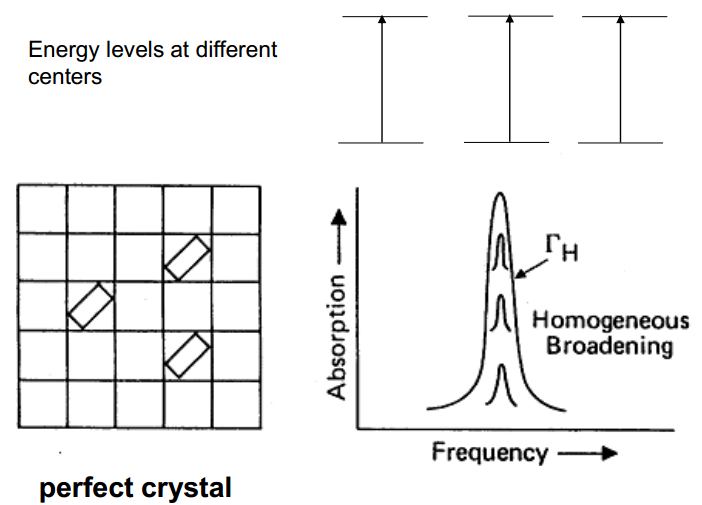 【Homogenous broadening】(或者说linewidth)来源于dynamic perturbations on the optical transition frequency:
【Homogenous broadening】(或者说linewidth)来源于dynamic perturbations on the optical transition frequency:
(1) lattice phonons;
(2) fluctuating nuclear or electron spins.
2. Inhomogeneous broadening
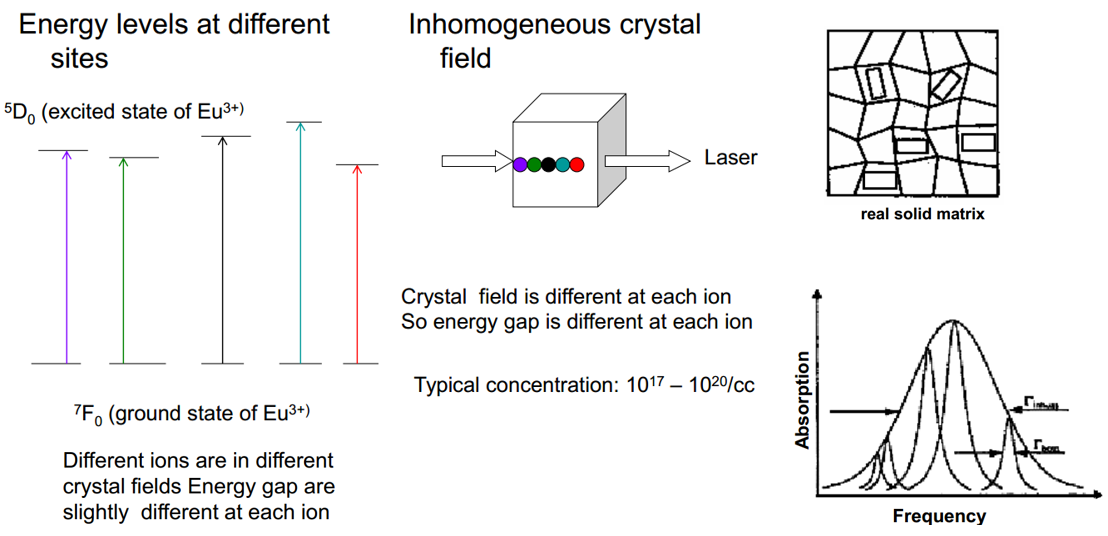
(1) Probability distribution of homogeneous single ion packets.
(2) Static lattice strains inherent in all samples.
(3) Small fraction of a wave number to many hundreds of wave number.
(4) 影响吸收谱,也影响发光谱等等。
The figure shows that this makes the ground and excited state energy to vary randomly from Eu3+ to Eu3+, which causes the transition frequency to change randomly as well.The probability of finding the transition frequency in a unit frequency interval {n,n+dn} is given by inhomogeneous distribution function, g(n). The absorption profile, which results from the superposition of many homogeneous line shapes is called inhomogeneously broadened absorption band. Mathematically, the inhomogeneous absorption band can be described as a convolution of the inhomogeneous distribution function with the function describing the homogeneous line shape. [Principles of Persistent Spectral Hole Burning-University of Montana]
3. Optical absorption transitions
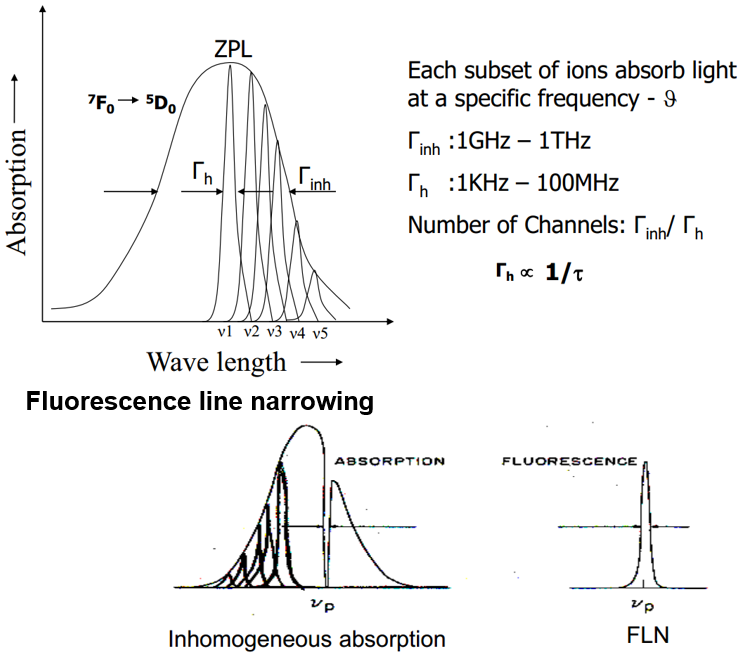 FLN:Fluorescence line-narrowing spectra (FLN),Fluorescence line-narrowing spectroscopy (FLNS) is useful for obtaining high-resolution optical spectra of molecules or atomic ions imbedded in amorphous solids for which conventional low-temperature absorption spectra yield broad vibronic bands.
FLN:Fluorescence line-narrowing spectra (FLN),Fluorescence line-narrowing spectroscopy (FLNS) is useful for obtaining high-resolution optical spectra of molecules or atomic ions imbedded in amorphous solids for which conventional low-temperature absorption spectra yield broad vibronic bands.
4. Optical hole burning
- High resolution spectroscopy technique: investigate ZPL
- Application: high density optical memory
- HB: selective bleaching of a subset of ions within the ZPL (inhomog.)
- Spectral hole burning
- Transient Hole burning (opt.pump.quadrupole levels)
- Persistent spectral hole burning
- Photophysical (change in environment, TLS interaction)
- Photochemical(ex: photoionization, bond breakage)
- Gated hole burning (Ex: two-photon ionization)
5. Photon gated hole burning
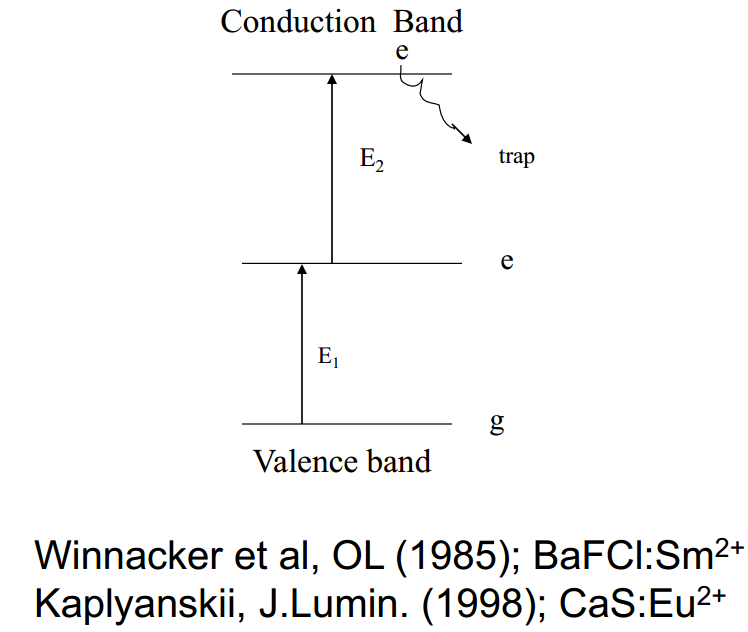 6. Required criteria for hole burning
6. Required criteria for hole burning
- ZPL: Inhomogeneous broadening
- Homogeneous linewidth < Inhomogeneous linewidth
- Narrow laser
- Exhibit FLN: narrow holes
- Material criteria
-
- No cross talk between holes
- Holes have to be permanent
- Burn holes with low power
- Potential to burn/retain more holes
-
7. 光学烧孔的研究目标:make materials for high temp. HB
(1) make materials for high temp. HB
(2) Improve the HB efficiency, hole density
8. 玻璃作为HB材料的优势
(1) Large inhomogeneous broadenings
(2) Vary the composition
(3) Easy to prepare samples
(4) PSHB
(5) Ruby- Al2O3:Cr3+和LaF3:Pr3+以及一些有机的HB材料是Pioneering HB work,目前研究的有Sodium borates/ Silicates/Borosilicates/Germanates/Tellurites
9. 两种烧孔模式
单光子烧孔:最大的缺陷在于经过多次读出后,会使有孔和无孔的差别变小,这个因素限制了存储数据可读取的次数。
双光子选通烧孔:同时用两个不同波长的光束照射才能完成,而读出时只用一束减弱的光束,因此不会发生读出的破坏原信息的问题。
10. 信息存储示意图
参考Laser Spectroscopy and its applications Changwon National University
第二部分photo-gated hole burning
参考[Photon-gated hole burning: a new mechanism using two-step photoionization-OL-1985]
Photo-gated hole burning: i.e., hole burning that occurs at a specific laser frequency \(\omega_h\) (必须是激光,能量/波长分布窄) only in the presence of a second gating light source, \(\omega_g\)(能量/波长分布不用很窄).
Significance: persistent spectral holes burned in this way are not degraded by probing with photons at \(\omega_h\). 两种模式对比如下:
(1) One-photon hole burning imposes a limitation on information storage since bleaching occurs during reading, limiting the number of reads before refreshing is required.
(2) Gated hole burning, however, occurs only in the presence of both frequency-selective and gating-light beams. In that way reading with one light beam only is nondestructive.
Frequency-domain optical storage: information is stored not just by means of a photoinduced modification of the material at a given spatial location but the frequency domain is used as an additional dimension by burning multiple (~103) spectral holes in an absorption line.

本文作者用了两个样品做实验,type-1样品的trap是Sm3+,type-2样品的trap未知,文章的主要内容都是type-1 样品的实验数据。上图的第一个公式表示的是photon-gated hole burning described as the photoionization reaction;上图的第二个公式表示的是electrons required to erase holes are provided by photoexcitation of Sm2+。
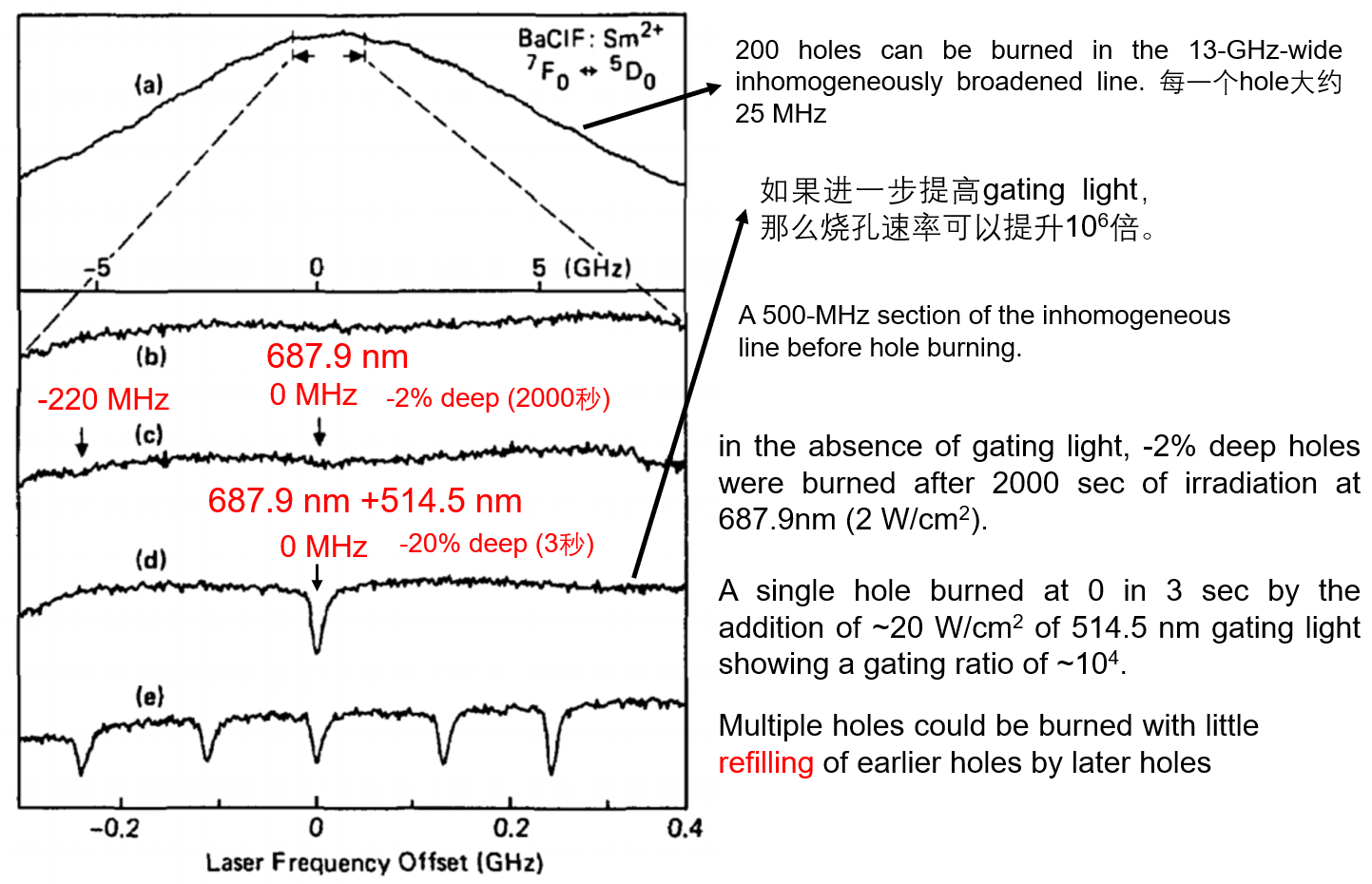 上图选用的是5D0作为中间能级,实际上用5D1也可行,结果类似。
上图选用的是5D0作为中间能级,实际上用5D1也可行,结果类似。

上面左图,The action spectrum of the gating shows a threshold behavior around 2.5 eV,正好对应于5D0到导带底的能量差(光电导实验也有类似的曲线图)。上面右图是擦除实验,正好是Sm2+的吸收谱的样子,说明Sm2+的电子被Sm3+捕获,然后新得到的Sm2+吸收光之后又返回Sm3+的状态。
热稳定性:2 K下烧孔,然后恢复到室温放几天,再降温到2 K,the holes had broadened by less than a factor of 2 with no discernable change in area. To our knowledgethis is the first material in whichstability of spectral holes under thermal cyclingto room temperature has been observed.
type-2样品实验结果的差异:
- In these samples a fairly large fraction of the absorption line (~50% compared with ~15% in the first group) can be burned away.
- The holes cannot be erased by light corresponding to the 4f55d absorption band of Sm2+.
- The holes are not stable on cycling to room temperature.
- By excitation of the transitions to 5D0 or 5D1, i.e., by red light only, transient holes with lifetimes shorter than 1 msec are produced almost 100%deep. However, gated hole burning produces persistent holes.
- Allthese observations point to the fact that in these samples electronic traps different from Sm3+ play a dominant role. The transient hole burning could be due to pumping to nearby traps from which recombination with Sm3+ is rapid.
优秀总结:It should be stated that the differences in holeburning and erasing behavior of different samples described above are of a quantitative rather than of a qualitative nature. Type I samples show to a small extent the features of type II, and vice versa. In fact it is the very nature of the photoionization process that the two kinds of behavior are closely intertwined. Even if there were no Sm3+ ions in the crystals originally, the Sm3+ produced by photoionization would eventually compete with the other traps for the electrons released to the conduction band, givingrise to behavior of type I; on the other hand there will always be electronic traps present in the crystal different from Sm3+, giving rise to behavior of type II. Which behavior is dominant will depend on the kinds of traps present and their concentration relative to that of the rare-earth ion in its divalent and trivalent states. Photoionizationhole burning is an intrinsic property of the system in as much (就……而言) as the level schemeof the ion, the position ofthe levelsrelative to the conduction band, etc., are involved. It is an extrinsic property inasmuch as electron traps determine important features of the hole-burning and -erasing process. This, apart from producing complex sample dependences, offers interesting possibilities for material engineering, one being deliberate doping of the material with trivalent rare-earth ions to act as traps.
第三部分-X射线辐照
以下来自[Room Temperature Hole-Burning of X-ray Induced Sm2+ in Nanocrystalline Ba0.5Sr0.5FCl0.5Br0.5:Sm3+ Prepared by Mechanochemistry-JPCA-2014] 1. 概述:Spectral hole-burning is a powerful technique in laser spectroscopy, and it is based on frequency selective bleaching of a subset of optical centers within an inhomogeneously broadened transition by a narrow band laser, resulting in a spectral hole (dip) in the absorption spectrum at the selected frequency.
2. 分类:On the basis of the stability of the spectral hole, the hole-burning mechanism can be classified into transient spectral hole-burning (TSHB) and persistent spectral holeburning (PSHB). Spectral holes in transient spectral hole-burning are usually based on excited state population storage and hence decay on the microsecond to millisecond time scale, while persistent spectral holes can have infinite lifetimes.
3. 机理:主要是两种
(1) Photochemical: occurs when a subset of chromophores within the inhomogeneously broadened transition undergoes a chemical reaction in the excited state upon selective excitation.
Possible chemical reactions in photochemical hole-burning include photoionization/ phototautomerism(光互变异构)/photodecomposition.
(2) Nonphotochemical (Photophysical): is based on slight structural rearrangements of the host−guest interactions in the local environment.
Nonphotochemical is a ubiquitous phenomenon for systems with hydrogen bonds, but translational movements or rotations of other atoms or groups of atoms can also lead to this effect.
4. 进阶photon-gated spectral hole-burning:In order to overcome bleaching and unwanted hole-burning during the readout process, photon-gated spectral hole-burning, especially employing rare-earth doped crystals, was explored. Winnacker et al. were the first to report photongated spectral hole-burning in Sm2+ ion doped BaFCl crystals at 2 K in 1985. 后面还有报道Sm2+掺杂玻璃,a color center in a halide crystal等等。
5. 评价指标\(\Gamma_{\mathrm{inh}} / \Gamma_{\mathrm{hom}}\):the figure-of-merit is expressed as the ratio of the inhomogeneous to the homogeneous line width,其中\(\Gamma_{\text {hom }}\)is half the width of the burnt hole in the ideal case.
6. Sm2+掺杂PbFCl family材料MyM1−yFXxX1−x (M = Ca, Sr, Ba; X = Cl, Br, I):inhomogeneously broadened line widths are mainly determined by the halide anions rather than the cations.
7. HB材料存在的问题:需要RT能有光学烧孔特性,这样才有可以实现frequency or time domain optical data storage的真正应用。虽然有一些RT的HB单晶/玻璃已经被报道了,但是relatively complex preparation methods at elevated temperatures and under a reducing atmosphere。然后作者开始介绍他的BaFCl:Sm3+ nanocrystals by ball milling at room temperature,然后用X射线辐照,即得到RT的HB材料。
8. 两种domain:
(1) time domain-photon echo, OFID, etc.
(2) Frequency domain-hole burning, FLN, etc.
第四部分
以下来自 [Principles of Persistent Spectral Hole Burning-University of Montana]
10. 不同温度下inhomogeneous absorption
 The figure shows the composition of the inhomogeneous absorption band at high (room) and at low (cryogenic) temperatures. At high temperatures the inhomogeneous spectrum is a superposition of many broad phonon-induced bands. Usually the width of the phonon bands is on the same order as the width of the inhomogeneous distribution function. In this case the absorption spectrum of molecules within the inhomogeneous band can be hardly be distinguished from each other. Such absorption band has practically no spectral selectivity. At low temperatures each molecule has a sharp zero phonon line. This allows groups of molecules to be addressed selectively based on their ZPL frequency. We say that in this case the material has a high degree of spectral selectivity.
The figure shows the composition of the inhomogeneous absorption band at high (room) and at low (cryogenic) temperatures. At high temperatures the inhomogeneous spectrum is a superposition of many broad phonon-induced bands. Usually the width of the phonon bands is on the same order as the width of the inhomogeneous distribution function. In this case the absorption spectrum of molecules within the inhomogeneous band can be hardly be distinguished from each other. Such absorption band has practically no spectral selectivity. At low temperatures each molecule has a sharp zero phonon line. This allows groups of molecules to be addressed selectively based on their ZPL frequency. We say that in this case the material has a high degree of spectral selectivity.
10. 有机材料hole burning的例子
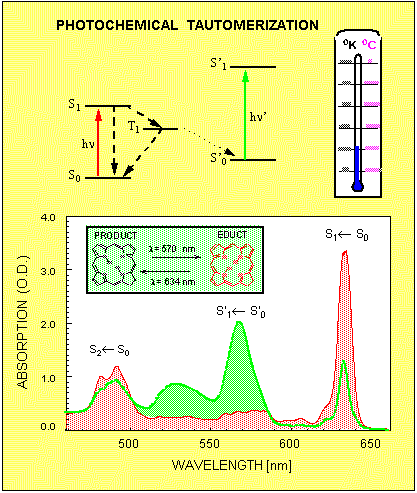 The figure shows the absorption profile taken before (red) and after (green) such illumination. Since at low temperatures the inhomogeneous absorption band of the educt consists of narrow zero phonon lines, it is possible to produce such photochemical transformations only in a small group of molecules, which are selected by their ZPL frequency. Selective bleaching of the inhomogeneously broadened absorption band consisting of narrow homogeneous absorption lines is called spectral hole burning (SHB). Besides the photochemical tautomerization reaction shown in the figure, there are many different mechanism for spectral hole burning in organic as well as in inorganic materials. In all cases the spectral hole burning relies on three basic factors: existence of narrow homogeneous zero phonon lines; existence of inhomogeneous broadening; existence of some kind of molecular of electronic mechanism, which alters the homogeneous absorption spectrum upon absorption of light.
The figure shows the absorption profile taken before (red) and after (green) such illumination. Since at low temperatures the inhomogeneous absorption band of the educt consists of narrow zero phonon lines, it is possible to produce such photochemical transformations only in a small group of molecules, which are selected by their ZPL frequency. Selective bleaching of the inhomogeneously broadened absorption band consisting of narrow homogeneous absorption lines is called spectral hole burning (SHB). Besides the photochemical tautomerization reaction shown in the figure, there are many different mechanism for spectral hole burning in organic as well as in inorganic materials. In all cases the spectral hole burning relies on three basic factors: existence of narrow homogeneous zero phonon lines; existence of inhomogeneous broadening; existence of some kind of molecular of electronic mechanism, which alters the homogeneous absorption spectrum upon absorption of light.
参考资料:
(1) 无机材料BaFCl0.5Br0.5:Sm2+光子选通光谱烧孔-光学学报, 1993
(2) Optical hole burning studies in europium doped glasses-PPT-B. Rami Reddy
(3) Laser Spectroscopy and its applications Changwon National University-PPT
(4) Principles of Persistent Spectral Hole Burning-University of Montana
(5) Selective spectroscopy of photosynthetic complexes and biomolecules
光学烧孔信息存储
SrB4O7 : Sm2z: crystal chemistry, Czochralski growth and optical hole burning
Stimulated luminescence and photo-gated hole burning in BaFCl0.8Br0.2:Sm2+,Sm3+ phosphors